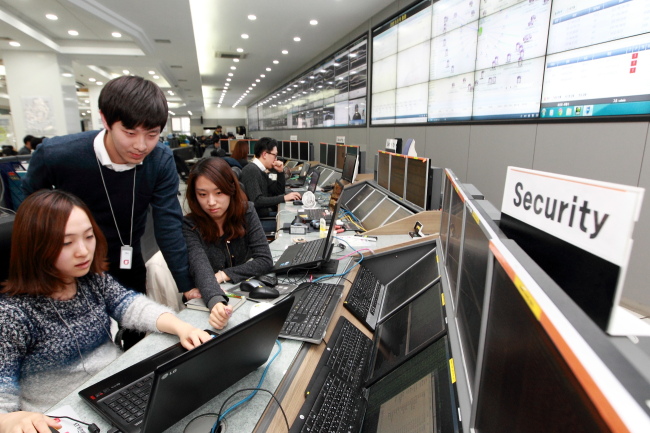KT, South Korea’s leading telecommunications firm, is seeking to take the lead in ushering forward the era of the 5G network, a next-generation mobile data service set to revolutionize the information and communications technology sector.
Promising maximum speeds of 100 gigabits per second, 5G technology is set to run up to 1,000 times faster than existing 4G mobile data network, enabling a new generation of ultra-efficient devices connected via the Internet.
To accelerate the implementation of the next-generation wireless technology worldwide, KT has been introducing a range of preceding technologies and striking partnerships with global telecom giants to lead what the firm calls “the next industrial revolution.”
Promising maximum speeds of 100 gigabits per second, 5G technology is set to run up to 1,000 times faster than existing 4G mobile data network, enabling a new generation of ultra-efficient devices connected via the Internet.
To accelerate the implementation of the next-generation wireless technology worldwide, KT has been introducing a range of preceding technologies and striking partnerships with global telecom giants to lead what the firm calls “the next industrial revolution.”

Pre-5G technologies
As a prequel to the forthcoming 5G technology, KT unveiled the world’s fastest mobile data service known as “GiGA LTE” in June.
The new service, which KT said is a “high-end technology that is about three years ahead of its time,” offers speeds up to 1.17 gigabits per second (Gbps) by merging the firm’s existing Long Term Evolution networks with localized Wi-Fi connections.
GiGA LTE takes the convergence of LTE and Wi-Fi networks, considered a core aspect of 5G technology, to new levels, enabling high network speeds on mobile devices.
KT’s commercialized eMBMS service enables up to 10 times higher-definition videos to multiple users concentrated in one place. Even with a high number of users, the service offers stable network connectivity.
Also central to the development of 5G technology is expanding the capacity of the base network stations. KT, with China’s Huawei, successfully demonstrated its Massive Multi-Input Multi-Output, or MIMO, system this year.
MIMO significantly drives up the reception capacity of base stations by simultaneously transmitting data via more than 100 antennas, compared just two or four antennas used for LTE, to offer expanded network capacities.
The Korean mobile carrier has also developed a range of technologies that supersede existing LTE technology, including the Millimeter Wave technology, which utilizes higher-frequency waves than those of LTE to achieve up to 1,000 times faster speeds, as well as 3-D Beam Forming, which positions multiple antennas at different angles to optimize transmission power.
Global partnerships for advancing 5G
KT has joined hands with a number of leading telecom giants from around the world including Nokia and Ericsson to jointly develop new cutting-edge technologies and establish new global standards for the 5G network.
In May, KT’s chief executive Hwang Chang-gyu visited Helsinki-based Nokia to discuss cooperative opportunities for 5G development. The two firms agreed to strengthen cooperation on the development of fiber-to-the-antenna technology, which combines offline fiber-to-the-home network with base network stations.
Moreover, they agreed to jointly develop mobile edge computing technology, which shortens delays in server reception by installing content servers directly inside the base stations.
The same month, KT and Stockholm-based telecom giant Ericsson successfully demonstrated the implementation of their jointly developed millimeter wave-based 5G multi-point transmission with distributed MIMO technology on a moving vehicle.
Millimeter waves in the ultra-high frequency wave band have often been offered up as alternatives to conventional low-frequency waves currently in use by LTE networks. However, it has been criticized for the technical difficulties of handling and controlling small cell traffic, which in turn reduces network coverage.
The two companies managed to address this problem by simultaneously connecting the multiple small cells to reduce cell loss, recording a network speed of up to 2 Gbps using their newly developed technology.
KT and Ericsson have sealed a memorandum of understanding as well for the development of LTE-M -- machine-to-machine LTE communication via Internet of Things technology.
Meanwhile, the Korean telecom giant recently established a “5G test bed” inside its research facilities in Seoul in a bid to more actively pursue new 5G tech development in partnership with its two overseas partners.
The world’s first 5G Olympics
Eyeing the development of 5G as a crucial part of propelling forward the nation’s ICT sector, KT has vowed to showcase its 5G network technology to the world at the upcoming PyeongChang Winter Olympics in 2018.
Though 5G is expected to be commercialized starting from 2020, KT is looking to rise up over its competition by introducing the revolutionary network technology to the world two years in advance during the international sporting event.
KT CEO Hwang has expressed high confidence in its 5G tech under development, vowing to showcase high-quality 5G network services fully equipped with the necessary software and network infrastructures.
By Sohn Ji-young (jys@heraldcorp.com)


















